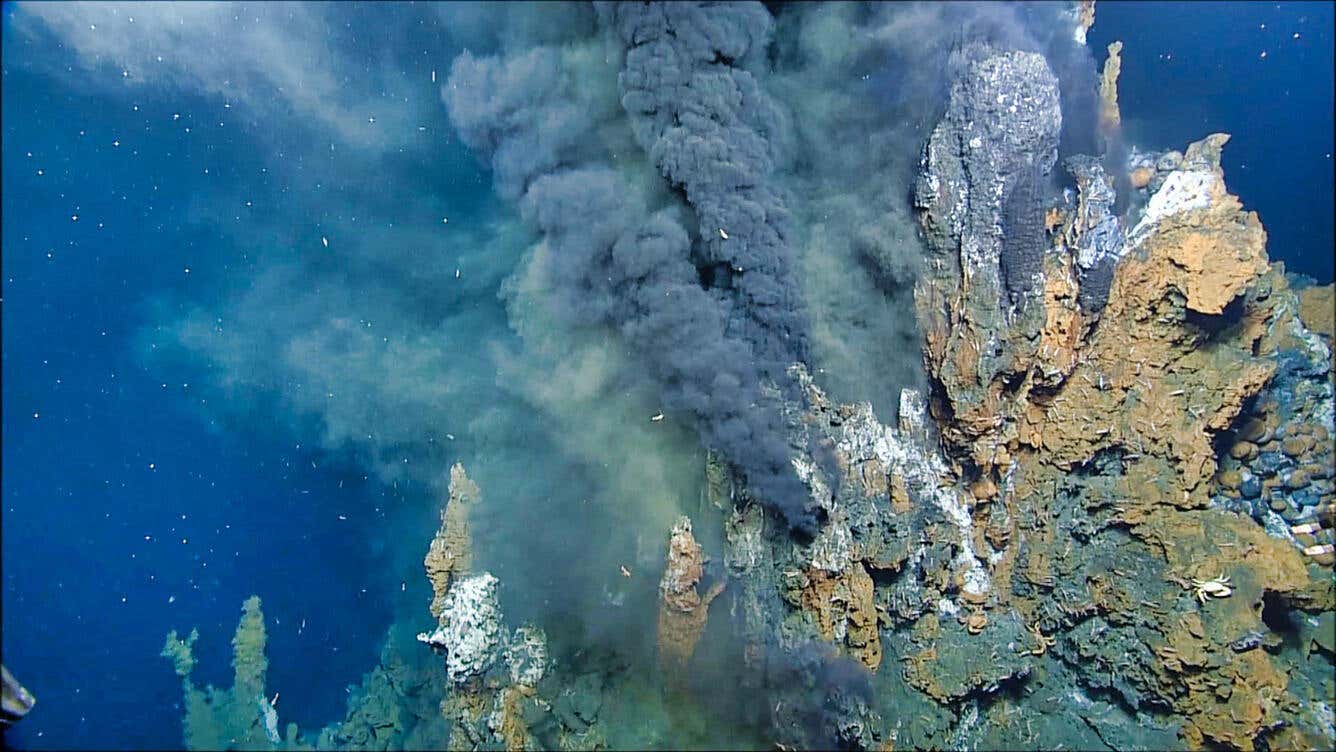Earth’s first life may have been sparked by underwater thermal vents
New study finds that natural voltage differences in ancient hydrothermal vents may have powered life’s first chemistry.

 Edited By: Joseph Shavit
Edited By: Joseph Shavit

Mineral-laden water emerging from a hydrothermal vent on the Niua underwater volcano in the Lau Basin, southwest Pacific Ocean. (CREDIT: Wikimedia / CC BY-SA 4.0)
Before sunlight ever reached the planet, another force may have sparked life—electricity. Deep beneath the ocean floor, ancient hydrothermal vents might have generated natural electric fields strong enough to turn carbon dioxide into the first organic molecules. A new study suggests these deep-sea “batteries” could have powered the chemistry that made Earth come alive.
Recreating the Birthplace of Life
To explore this idea, researchers recreated the conditions of early Earth’s seafloor in the lab. They mimicked hydrothermal vents—cracks where hot, mineral-rich water meets cold seawater. These vents, filled with iron and nickel sulfides, naturally create stable gradients in temperature, acidity, and chemistry. Those gradients can produce tiny electric voltages, much like the ones that power living cells today.
In their experiment, scientists built small reactors separated by iron sulfide walls. One chamber held hot, hydrogen-rich fluid; the other contained cold, carbon dioxide–rich seawater. This setup produced a steady electric current, just as ancient oceans might have done four billion years ago.
Without sunlight, enzymes, or life itself, the current began converting carbon dioxide into simple organic molecules. The team detected formic and acetic acids—essential ingredients in the earliest metabolic reactions. All it took was a natural flow of electrons through the mineral barrier.
Iron Sulfide: Nature’s First Catalyst
Iron sulfide (FeS) didn’t just conduct electricity—it acted like a primitive enzyme. It guided electrons and encouraged carbon dioxide and hydrogen to react, forming organic compounds. Interestingly, iron-sulfur clusters still play a key role in modern enzymes that generate cellular energy, hinting that life may have evolved directly from this ancient chemistry.
The best results occurred between 70°C and 120°C—the same range found in real hydrothermal vents. The voltage across the FeS barrier, between 150 and 250 millivolts, closely matched the potential across modern cell membranes. This remarkable similarity points to a deep evolutionary link between rocks and life.
How Rocks Became Cells
Thiago Altair Ferreira, who led the study at the University of São Paulo and Japan’s RIKEN Institute, said the voltages seen in the experiment are comparable to those that power mitochondria—the “batteries” of cells. “It’s this voltage that sustains the chemical reactions,” he explained. The team wanted to see if electricity alone could turn CO₂ into organic matter—and it did.
Even weak electric currents, only billionths of an ampere, were enough to keep the reactions going. Ferreira believes these gentle currents could have fueled a “protometabolism”—a primitive version of the chemical cycles that energize life today. The results show that early Earth didn’t need sunlight or enzymes to begin life—just the right minerals, fluids, and electricity.
The organic acids created in the experiment resemble molecules used in the Wood-Ljungdahl pathway, one of the oldest metabolic routes still found in bacteria today. This suggests life may have inherited its first energy systems from geological processes themselves.
The researchers also found that stronger differences in temperature and pH increased the production of organic molecules. The bigger the gap between “vent” and “ocean” conditions, the more efficiently CO₂ converted into organics—making hydrothermal vents ideal cradles for life.
Electricity: The First Engine of Life
The study proposes that natural electric fields within minerals could have served as Earth’s first power source. These voltages mirror those that drive ATP production—the main energy system in living organisms. Today, proton gradients across cell membranes power ATP synthase, the enzyme that makes cellular energy. Billions of years ago, minerals may have played the same role before proteins evolved.
This work supports the “alkaline hydrothermal vent” theory, which suggests life began not in random chemical chaos but in structured, energy-rich environments. The vents continuously generated organic materials using heat and natural voltage gradients. Over time, these compounds became energy carriers that eventually led to the first cells.
The findings also hint that life could arise elsewhere. Hydrothermal vents exist on moons and planets like Europa, Enceladus, and Mars. If similar electric gradients occur there, they might power the same chemistry that once sparked life on Earth. “Understanding these systems helps us imagine how oceans on another planet could give rise to biology,” Ferreira said.
Ancient Chemistry, Modern Solutions
This research not only reimagines how life began—it could also help combat climate change. The same electrochemistry that may have birthed life could inspire new carbon-capture and clean-fuel technologies. Ferreira hopes to harness mineral-based catalysis to make CO₂ conversion cheaper and more energy-efficient.
His doctoral adviser, Professor Hamilton Varela, praised the study for connecting multiple fields. “It provided experimental evidence of how temperature, pH, and potential gradients reduce CO₂ and opened valuable new directions in the field,” he said. The project brought together scientists from Brazil, Japan, Britain, and the U.S. in a global effort to trace life’s deepest origins.
A New Vision of Life’s Origin
The study challenges the old “primordial soup” idea, which portrays life as a product of random chemical reactions. Instead, it suggests a more ordered beginning—guided by constant, natural energy. “The origin of life is not a soup of organic compounds but order in the right place at the right time,” Ferreira said. Life, in this view, wasn’t an accident—it was chemistry’s natural next step.
By linking real geological settings to measurable electrical reactions, the researchers turned an ancient theory into a working experiment. Their results suggest that the same forces that power life today were already active in Earth’s early oceans—when rocks first learned how to live.
Why It Matters
This study deepens our understanding of how energy gradients drive the chemistry of life—and how similar conditions might exist elsewhere in the universe. It also offers a blueprint for cleaner energy on Earth.
By learning from ancient minerals that turned CO₂ into organic molecules, scientists could design more sustainable systems for capturing carbon and producing fuels.
Research findings are available online in the Journal of the American Chemical Society.
Related Stories
- Scientists discovered a massive hydrothermal world hidden beneath the Pacific Ocean
- Researchers find life thriving deep under the Earth's surface
- Ancient Hot Springs Offer Key Insights to Earth's Origin of Life
Like these kind of feel good stories? Get The Brighter Side of News' newsletter.
Joshua Shavit
Science & Technology Writer and Editor
Joshua Shavit is a Los Angeles-based science and technology writer with a passion for exploring the breakthroughs shaping the future. As a co-founder of The Brighter Side of News, he focuses on positive and transformative advancements in AI, technology, physics, engineering, robotics and space science. Joshua is currently working towards a Bachelor of Science in Business and Industrial Engineering at the University of California, Berkeley. He combines his academic background with a talent for storytelling, making complex scientific discoveries engaging and accessible. His work highlights the innovators behind the ideas, bringing readers closer to the people driving progress.



